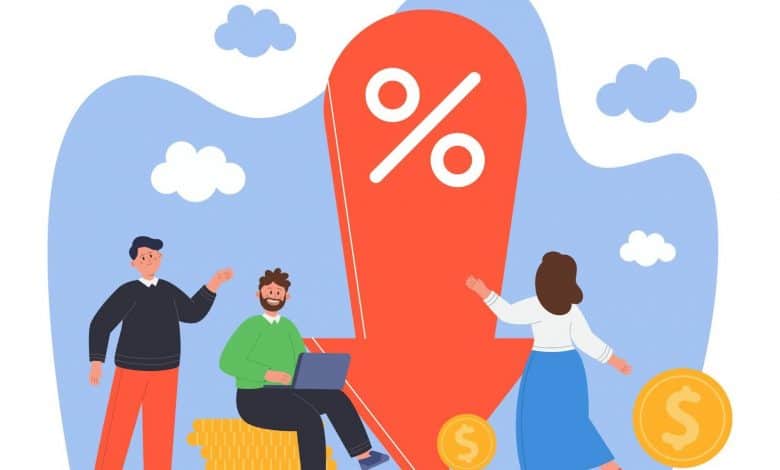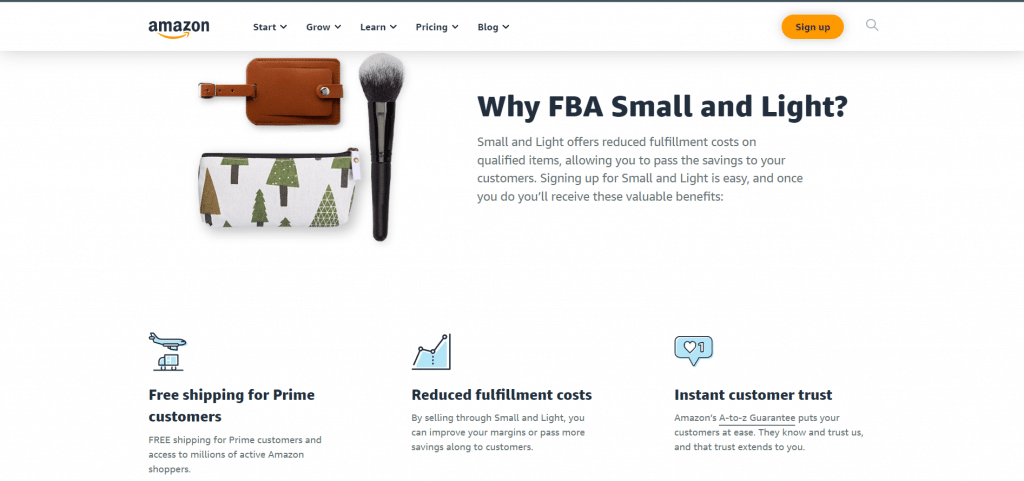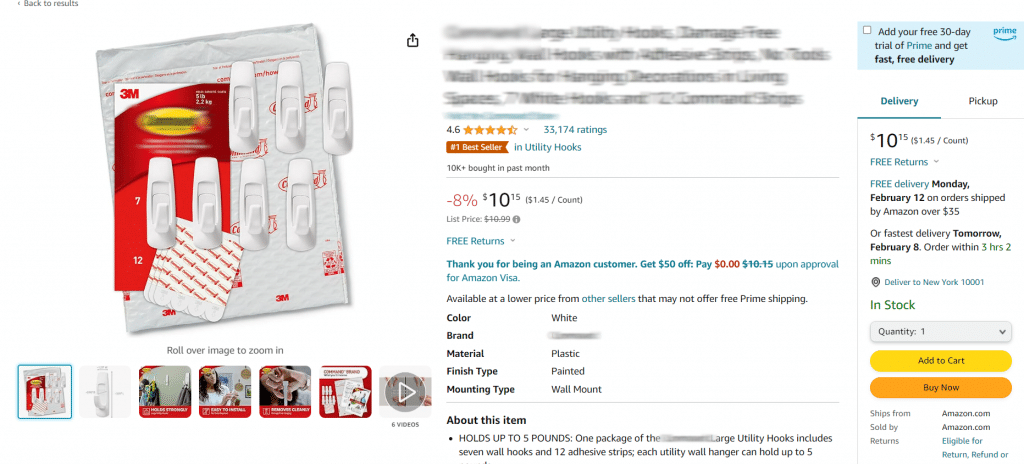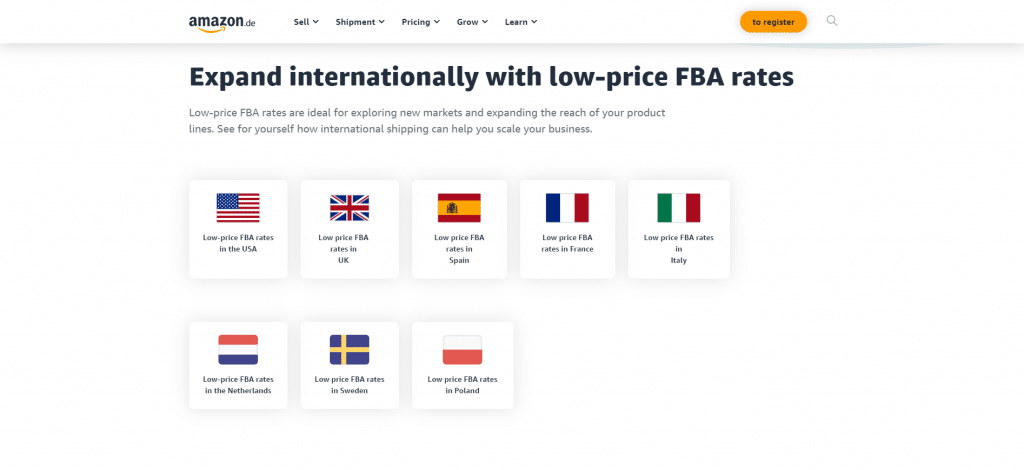Understanding Amazon’s Low Price FBA Fees
Everything You Need to Know About the Program That Replaced Amazon Small & Light

The path to becoming a successful seller on Amazon is never easy. Amazon often makes changes to its search algorithm, issues price hikes on fees, introduces new products from its private label brand, and switches up its programs.
One of the notable changes it made was replacing the Small and Light Program with Low Price FBA fees. In this article, we’ll discuss the Low Price FBA fees program, why Amazon made the change, ways the two differ, and how sellers will be affected.
What Was the Small & Light Program and Why Did Amazon Get Rid of It?

Before the change made last August 29, 2023, Small and Light was a program that offered reduced fulfillment fees to sellers who sold small, lightweight items priced under $12 that weighed less than 3 lbs and measured less than 18 x 14 x 8 inches. This program has been in place since June 2015.
Aside from lower shipping fees compared to standard FBA, Small and Light was a way for sellers to reduce the price of their products and pass on the savings to their customers. For Amazon’s sake, the program was geared to help them further expand the items on their marketplace to attract more buyers and sellers.
As good as the program was, it wasn’t perfect either. Small and Light was only available in select countries and had stringent packaging requirements which limited the way sellers could ship their products on top of not getting the benefits of Prime delivery.
Related Reading: Amazon Is Retiring The Small and Light Program: What You Need to Know
Since sellers knew the pros (cheaper shipping fees) and cons (slower delivery time) of enrolling their items in Small and Light, why did Amazon choose to remove it eight years later?
The main (and only) reason Amazon gave as to why it chose to discontinue Small and Light was to provide sellers in the program with faster delivery since they claimed their customers had become accustomed to receiving orders from Amazon within one or two days.
However, their initial announcement sparked an uproar among sellers. After spending years finding the perfect sales strategy to try and become profitable on Amazon, now they have to start from scratch thanks in large part to the minimum price for products to be eligible in Low Price FBA fees getting dropped from $12 to $10.

The new announcement states:
“The new FBA rates for low-price products will be an average of $0.77 lower per item than the current FBA rates for these products. If your products were enrolled in Small and Light and are priced below $10, this change will mean that you will pay about $0.30 more per item than with Small and Light.”
Notice how Amazon is comparing the now disqualified products (priced between $10 and $12) with the current FBA rates, not with the Small & Light rates they had before. Of course, this doesn’t mean that sellers are saving money on anything. The reality with Low Price FBA fees is that most sellers will have to pay the additional extra $.30 for every product sold.
For this change to have helped sellers, keeping the $12 threshold would have been the right move since 88% of customers are willing to pay more for a product anyway as long as it can be delivered on the same day.
What Is Amazon’s Low Price FBA Fees Program?
Amazon's Low Price FBA fees program was introduced so that sellers could ship cheaper items with the benefits of standard FBA to Amazon Prime members.
Their current policy states that all products priced under $10 will automatically be enrolled in low price FBA fees while items priced above will automatically be charged the regular FBA rates. Similar to Small and Light, items listed under Amazon’s restricted category still won’t be eligible for Low Price FBA fees.

On the surface, the change is most beneficial to sellers who sell cheap items that measure beyond 18 x 14 x 8 inches and weigh more than 3 lbs. But as you read along this article, the change comes with a few flaws.
After five months into the program, Amazon has already made changes to the shipping fees of products in every single category. Items that qualify in the small standard category will be measured at intervals of 2 ounces.
Products in the large standard size tier from 1+ to 20 lb will now be measured at intervals of 4 ounces. While products in the oversize category, regardless of whether it’s in the small, medium, large, or special category, will follow new weight and dimension definitions.
Take a look below at the change in fees over the past few months from when Amazon had Small and Light to when they first introduced Low Price FBA fees and what sellers will have to pay moving forward.
| Size tier | Shipping weight | Regular FBA fees excluding apparel (before change in intervals) | Low Price FBA fees excluding apparel (before change in intervals) | Small and Light fees |
| Small standard | 4 oz. or less | $3.22 | $2.45 | $2.47 |
| 4 + to 8 oz | $3.40 | $2.63 | $2.54 | |
| 8 + to 12 oz | $3.58 | $2.81 | $2.61 | |
| 12 + to 16 oz | $3.77 | $3.00 | $3.15 | |
| Large standard | 4 oz or less | $3.86 | $3.09 | $2.66 |
| 4 + to 8 oz | $4.08 | $3.31 | $2.77 | |
| 8 + to 12 oz | $4.24 | $3.47 | $2.94 | |
| 12 + to 16 oz | $4.75 | $3.98 | $3.77 | |
| 16 oz + to 1.5 lbs | $5.40 | $4.63 | $4.42 | |
| 1.5 lbs + to 2 lbs. | $5.69 | $4.92 | $4.68 | |
| 2.0 + to 2.5 lbs. | $6.10 | $5.33 | $5.19 | |
| 2.5 + to 3 lbs. | $6.39 | $5.62 | $5.40 |
| Size tier | Shipping weight | FBA fees excluding apparel before April 15, 2024 | FBA fees excluding apparel by April 15, 2024 | Low Price FBA fees excluding apparel before April 15, 2024 | Low Price FBA fees excluding apparel by April 15, 2024 |
| Small standard | 2 oz. or less | $3.22 | $3.06 | $2.45 | $2.29 |
| 2 + to 4 oz | $3.31 | $3.15 | $2.54 | $2.38 | |
| 4 + to 6 oz | $3.40 | $3.24 | $2.63 | $2.47 | |
| 6 + to 8 oz | $3.49 | $3.33 | $2.72 | $2.56 | |
| 8+ to 10 oz | $3.58 | $3.43 | $2.81 | $2.66 | |
| 10+ to 12 oz | $3.68 | $3.53 | $2.91 | $2.76 | |
| 12+ to 14 oz | $3.77 | $3.60 | $3.00 | $2.83 | |
| 14+ to 16 oz | $3.82 | $3.65 | $3.05 | $2.88 | |
| Large standard | 4 oz or less | $3.86 | $3.68 | $3.09 | $2.91 |
| 4 + to 8 oz | $4.08 | $3.90 | $3.31 | $3.13 | |
| 8 + to 12 oz | $4.32 | $4.15 | $3.55 | $3.38 | |
| 12 + to 16 oz | $4.75 | $4.55 | $3.98 | $3.78 | |
| 1 + to 1.25 lbs | $5.19 | $4.99 | $4.42 | $4.22 | |
| 1.25+ to 1.5 lb | $5.57 | $5.37 | $4.80 | $4.60 | |
| 1.5+ to 1.75 lb | $5.75 | $5.52 | $4.98 | $4.75 | |
| 1.75+ to 2 lb | $6.00 | $5.77 | $5.23 | $5.00 | |
| 2+ to 2.25 lb | $6.10 | $5.87 | $5.33 | $5.10 | |
| 2.25+ to 2.5 lb | $6.28 | $6.05 | $5.51 | $5.28 | |
| 2.5+ to 2.75 lb | $6.45 | $6.21 | $5.68 | $5.44 | |
| 2.75+ to 3 lb | $6.86 | $6.62 | $6.09 | $5.85 | |
| 3+ lb to 20 lb | $7.25 + $0.08 per 4 oz interval above first 3 lb | $6.92 + $0.08 per 4 oz interval above first 3 lb | $6.48 + $0.08 per 4-oz interval above first 3 lb | $6.15 + $0.08 per 4-oz interval above first 3 lb |
From the two tables shown above, items excluding apparel in the small standard size tier will pay around $.09 more moving forward if the items weigh 3 oz, 5 oz, 7 oz, 9 oz, and 11 oz. For items in the large standard tier excluding apparel, sellers will now save around $.20 to $.25 on regular FBA and low price FBA fees.
| Size tier | Shipping weight | Regular FBA fees for apparel (past) | Regular FBA fees for apparel starting April 15, 2024 | Low Price FBA fees for apparel (past) | Low Price FBA fees for apparel starting April 15, 2024 |
| Small standard | 4 oz. or less | $3.43 | $3.27 | $2.66 | $2.50 |
| 4 + to 8 oz | $3.58 | $3.42 | $2.81 | $2.65 | |
| 8 + to 12 oz | $3.87 | $3.72 | $3.10 | $2.95 | |
| 12 + to 16 oz | $4.15 | $3.98 | $3.38 | $3.21 | |
| Large standard | 4 oz or less | $4.43 | $4.25 | $3.66 | $3.48 |
| 4 + to 8 oz | $4.63 | $4.45 | $3.86 | $3.68 | |
| 8 + to 12 oz | $4.84 | $4.67 | $4.07 | $3.90 | |
| 12 + to 16 oz | $5.32 | $5.12 | $4.55 | $4.35 | |
| 16 oz + to 1.5 lbs | $6.10 | $5.90 | $5.33 | $5.13 | |
| 1.5 lbs + to 2 lbs. | $6.37 | $6.14 | $5.60 | $5.37 | |
| 2.0 + to 2.5 lbs. | $6.83 | $6.60 | $6.06 | $5.83 | |
| 2.5 + to 3 lbs. | $7.05 | $6.81 | $6.28 | $6.04 |
For items under apparel, the intervals still have the same increments and will now be priced around $.15 to $.20 less on both regular FBA and low price FBA fees.
| Old size and shipping for non standard size tiers | ||
| Size tier | Shipping weight | FBA fees for non apparel |
| Small oversize | 70 lbs or less | $9.73 + $.42/lb interval above first lb |
| Medium oversize | 150 lbs or less | $19.05 + $.42/lb interval above first lb |
| Large oversize | 150 lbs or less | $89.98 + $.83/lb interval above first 90 lb |
| Special oversize | Over 150 lbs | $158.49 + $.83/lb interval above first 90 lb |
| New size and shipping for non standard size tiers | ||
| Large bulky | 0 to 50 lbs | $8.84 + $0.38/lb-interval above first lb |
| Extra-large 0 to 50 lb | 0 to 50 lbs | $25.56 + $0.38/lb-interval above first lb |
| Extra-large 50+ to 70 lb | 50+ to 70 lb | $39.35 + $0.75/lb-interval above 51 lb |
| Extra-large 70+ to 150 lb | 70+ to 150 lb | $54.04 + $0.75/lb-interval above 71 lb |
| Extra-large 150+ lb | 150 lb | $194.18 + $0.19/lb-interval above 151 lb |
* The tables above show the fees for items in the US. To know the updated list of Low Price FBA fees in other marketplaces, you can check Amazon’s Low Price FBA fees page.
Between Small and Light and Low Price FBA fees, there are three main differences: product eligibility, shipping speed, and shipping cost.
| Product eligibility | In Small and Light, products had to have the following requirements Item must be less than 3 lbsHas measurements of 18 x 14 x 8 inches or lessLess than $12Must be brand newSold at least 25 units in the past month With Low Price FBA fees, the only requirement is that the item must be priced under $10. |
| Shipping speed | In Small and Light, eligible products experienced a delivery time of 3 to 5 days. For items in low price FBA fees, customers can now get the benefit of faster shipping. |
| Shipping costs. | Even with the updated fees, most items in Small and Light had cheaper fees compared to Low Price FBA fees. For the large standard 4 oz or less shipping weight for example, in Small and Light, the fee would only be $2.66. With Low Price FBA fees, the fee jumps to $2.91. |
Why Did Amazon Drop the Minimum Price of Low Price FBA Fees from $12 to $10?
It’s hard to pinpoint the exact reason why Amazon chose to reduce the minimum price of products to be eligible for Low Price FBA fees when shipping costs are more contingent on an item’s weight than its price.
But one of the problems sellers did have with Small and Light was that they’d get confused with the requirements needed to qualify aside from pricing their products under $12.
With Low Price FBA fees in effect, all sellers need to do is sell products under $10. The problem for sellers now is whether they can afford to price their products under $10.
In Amazon's announcement posted on their seller forum, one seller responded:
“This move can be seen as another way Amazon can increase its profits from its fulfillment services, but does come at a risk to its customers and sellers.”
From a seller’s standpoint, some could lose interest in selling on its platform since they’ll have to pay more for certain products.
What Problem Will Sellers Have With Amazon’s Low Price FBA Fees?
While sellers now do get the benefit of having their products come with Amazon’s coveted Prime delivery, the change will ultimately eat up their profit margins in the long run. To give you a better perspective, here’s an example.
Suppose you sell a product that initially costs $9.79. Since you wanted to maximize the benefits of Small and Light, you priced that item at $11.99. This now gives you around a $2 profit on every item sold. However, through the Low Price FBA Fees program, the profit drops to 20 cents since the most you can price your product will be $9.99.
That doesn’t even take into account inflation rates that continue to increase at a steady rate and money spent on advertising.
If you choose to stand pat and keep the price of your products as is, you’ll be inclined to increase the price eventually to offset the cost of standard FBA fees. This may discourage customers since price is still the main consideration for most Amazon customers.
Sellers who priced their products in the $10 to $11.99 range will be most affected by the loss of Small and Light, as they will need to evaluate whether they should raise prices to offset the loss in savings from shipping or reduce prices by almost $2, resulting in a lower profit margin.

What are the Pros and Cons of Low Price FBA Fees?
As with every program on Amazon, each carries a few pros and cons and the Low Price FBA fees program is no different.
Pros
- Requirements for product eligibility are straightforward.
- Some sellers will save on fulfillment fees.
- Faster shipping on products under $10.
Cons
- Potential for lower price margins due to a decrease in the minimum price threshold.
- Limited to products under $10
- Some sellers will have to spend more on fulfillment fees.
Final Thoughts
With the new change, sellers who had products that couldn’t meet the criteria of Small and Light can now save an average of $.77 on fulfillment fees. But in reality, the savings depend on the weight of your product. Either way, this change will force sellers who sold items between $10 to $12 in a very tough spot.
Overall, the move hurts sellers more than it benefits them. While some products that didn’t pass the weight limit for Small and Light now pay smaller fees, dropping the prices of items by almost $2 to be eligible for Low Price FBA fees will lead to lower revenue. The same also applies if you choose to keep your price as is since you’ll have to pay more for shipping.
How has your business changed now that Amazon switched from Small and Light to Low Price FBA fees? Share your thoughts in the comments below!



